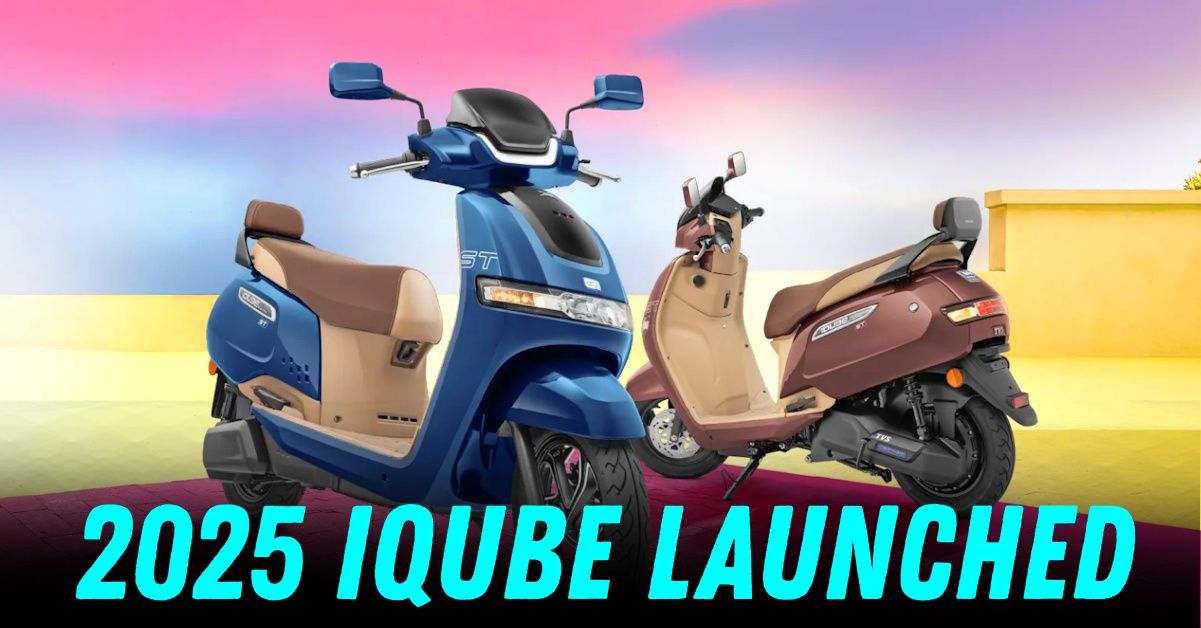2025 TVS iQube S And ST Electric Scooters Launched With Bigger Battery, More Features


TVS Motor Company has unveiled the 2025 iterations of its iQube S and ST electric scooters, introducing substantial improvements in battery capacity, range, and design. The updated models arrive as the Indian electric two-wheeler market intensifies, with competitors like Ola Electric and Ather Energy vying for dominance. Priced between ₹1.09 lakh and ₹1.59 lakh (ex-showroom), the new iQube lineup targets urban commuters seeking reliability, extended range, and premium features.
The iQube S now features a 3.5kWh battery, up from 3.3kWh, delivering an IDC-certified range of 145 km per charge. This upgrade addresses one of the most common concerns among electric vehicle adopters: range anxiety.
The flagship iQube ST receives a more significant boost, with its battery capacity increasing from 5.1kWh to 5.3kWh, pushing its range to 212 km-a figure that positions it as one of the longest-range electric scooters in India. Both models retain their previous top speeds of 78 km/h (S) and 82 km/h (ST), ensuring compatibility with highway commuting.
TVS has adopted a tiered pricing strategy to cater to diverse budgets. The iQube S is available in two variants: a base model with a 5-inch digital display (₹1.09 lakh) and a premium variant with a 7-inch TFT touchscreen (₹1.17 lakh).
The iQube ST offers greater flexibility, with a 3.5 kWh variant priced at ₹1.28 lakh and the top-spec 5.3 kWh model at ₹1.59 lakh. This approach allows TVS to compete across multiple segments, from budget-conscious riders to those prioritizing advanced features.
Aesthetic upgrades distinguish the 2025 models. The iQube ST sports beige inner panels, a dual-tone seat, and an integrated pillion backrest for improved comfort. Both scooters retain practical elements like a 32-litre underseat storage compartment (30 litres for the base S variant) and USB charging ports.
The 7-inch TFT display on higher variants continues to offer turn-by-turn navigation, tyre pressure monitoring, and smartphone connectivity. In the past, there has been an occasional lag in the interface during navigation-heavy usage so we will have to wait and see if that is now addressed.
The updated iQube series faces stiff competition. Ola Electric’s S1 Pro, with its 195 km range, and Ather Energy’s 450X, known for its agile handling, remain key rivals. Bajaj’s Chetak Premium, though lacking in range compared to the iQube ST, undercuts it on pricing.
TVS seems to be betting on its established service network and brand reputation to counter newer entrants. The company seems to have decided to avoid aggressive price cuts, unlike some competitors, and it reflects confidence in its product differentiation.
Long-term users praise the iQube’s suspension setup, which handles potholes and speed bumps with ease, a critical advantage in Indian urban conditions. The scooters’ hub-mounted motors operate near-silently, reducing noise pollution in crowded areas.
However, some riders have noted that the acceleration feels gradual compared to rivals, a trade-off for the smoother power delivery preferred in stop-and-go traffic. The ergonomic seat design, offering ample space for rider and pillion, has been consistently highlighted as a strength.
Bookings for the 2025 iQube series are now open across TVS dealerships, with deliveries expected to begin by late June. The company has expanded its EV-specific service centers to over 150 cities, addressing past concerns about maintenance accessibility.
TVS is also rumored to be developing an entry-level electric scooter priced below ₹1 lakh, slated for launch during the 2025 festive season. This could further solidify its position in a market where affordability remains a key driver.
While the iQube supports standard home charging (0–80% in 4.5 hours for the ST variant), TVS has also partnered with select shopping malls and office complexes in metro cities to install dedicated charging stations, though coverage remains limited compared to petrol refueling networks.
The 2025 iQube launch underscores TVS’s commitment to evolving its electric portfolio amid shifting consumer preferences. With range improvements and subtle design tweaks, the models aim to appeal to both existing EV enthusiasts and those transitioning from petrol-powered scooters. As charging infrastructure expands and battery costs decline, analysts predict such upgrades will become critical for maintaining market relevance.